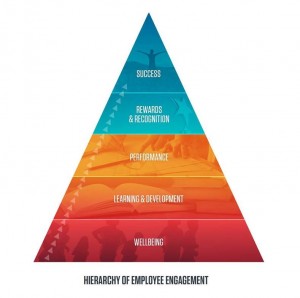Open any business magazine, scroll through any human resources group on LinkedIn, or navigate to any industry blog, and you’re bound to see the same two words: employee engagement. It’s a long-standing corporate obsession, understood as fundamental to worker productivity, retention, and overall business performance. Yet, despite its importance, employee engagement rates remain low. A recent global survey from Aon Hewitt found that just 24% of employees are highly engaged at work.
The traditional methods for fostering employee engagement are failing. Tools like learning and development programs, rewards and recognition platforms, and engagement surveys, while useful and well-intentioned, have generated only incremental or short-term impact on employee engagement. That’s because these approaches don’t address the basic foundational need of employees: personal wellbeing.
It’s time for a new approach.
If employees don’t bring their best selves to work every day – feeling physically, mentally, and emotionally prepared to work – nothing else matters. If they’re not staying physically active, eating a healthy diet, sleeping well, and managing their stress, they’ll lack the focus, energy, and drive to succeed. Without wellbeing, employees won’t have the focus to acquire new skills and grow professionally because they’ll be distracted and mentally foggy. They won’t have the energy to improve their performance because they’ll be tired and depleted. Unless they have a strong foundation of wellbeing, employees will lack the drive to do stellar work that is worthy of recognition, and thus they won’t achieve their optimal level of success at work.
Wellbeing, I believe, is the first and most important step to achieving sustainable employee engagement. Fortunately, the human resources industry appears to be evolving toward this way of thinking. Industry analyst Josh Bersin from Deloitte made the following observation in 2016 as he was analyzing shifts the greater HR software market:
“In today’s always-on environment, our ability to ‘stay well’ and maintain a fit attitude and frame of mind, has a huge impact on our engagement and performance. And the organization must take responsibility for building a work environment which facilitates and supports fitness: from exercise to food to work environment to management.”

What Bersin is describing supports a new framework for employee engagement that positions wellbeing as the foundation, and places everything else – growth, performance, and success – upon its base. This is analogous in many ways to Maslow’s hierarchy: you can’t reach the goal at the top of the pyramid without first fulfilling the critical needs below it.
Zachary Chertok, research analyst at Aberdeen, wrote a white paper about employee wellness. In it, he makes the case that offering wellbeing solutions to employees is a crucial way to get them engaged at work:
“Wellness solutions go beyond reactive rewards and recognition to provide insights into what might be dragging down worker participation in internal goals and objectives. Furthermore, while top-level company goals and objectives suffer in the proverbial game of telephone on the way to become team or departmental goals and objectives, wellness solutions give employers the ability to enforce their mission and vision to their employees directly as a form of workforce resource investment and deployment.”
In other words, investing in the wellbeing of employees is proactive and a direct way to connect with employees. As Chertok writes in his conclusion:
“For employees, wellness resources demonstrate that employers have resources in place to show that they care on multiple levels, which results in increased employee engagement.”
Industry research also supports this model for employee engagement. In a recent survey by Xerox, now Conduent, 86% of employers said that wellbeing is the single factor that has the largest impact on employee engagement, and 74% view their wellbeing program as an important element of the employee value proposition.
We all want our employees to be engaged at work – to learn, grow, advance, achieve, and maximize their success. So I’m encouraged that so many employers who have historically treated employee wellbeing as a health care cost containment strategy or a check-the-box benefit are beginning to re-think their approach. They’re now treating it as a foundational building block for employee engagement—and ultimately, business success. I think renowned entrepreneur Sir Richard Branson says it best: “Take care of your employees, and they’ll take care of your business.”
 Rajiv Kumar serves as Chief Medical Officer and President of Virgin Pulse Institute. Dr. Kumar joined Virgin Pulse in 2016, following the company’s acquisition of ShapeUp, an employee wellbeing company that he founded in 2006. Dr. Kumar earned his medical degree from the Warren Alpert Medical School of Brown University and has a Bachelor of Arts in Business Economics from Brown University.
Rajiv Kumar serves as Chief Medical Officer and President of Virgin Pulse Institute. Dr. Kumar joined Virgin Pulse in 2016, following the company’s acquisition of ShapeUp, an employee wellbeing company that he founded in 2006. Dr. Kumar earned his medical degree from the Warren Alpert Medical School of Brown University and has a Bachelor of Arts in Business Economics from Brown University.

Comments are closed.
Excellent insights … now, let’s get more employers on board!
[…] & Chief Medical Officer, Dr. Rajiv Kumar, wrote a featured blog post for HERO titled, “Wellbeing Is The Foundation of Employee Engagement.” In the piece, Dr. Kumar lays out a new approach to employee engagement, positioning wellbeing as […]